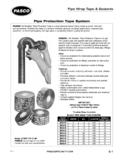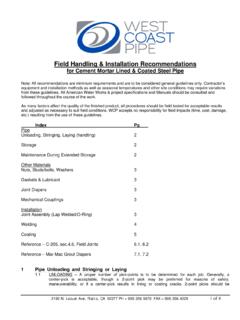Transcription of Mitigation of Pipe End Coating Disbondment
1 Mitigation of pipe End Coating Disbondment <<<<<<<<<<<<<<<<<<<<<<<<<< Dr. Shiwei William Guan >>>>>>> NACE InternationalAbstract:Storage of coated pipes for an extended period without any preservation , especially in some marine and tropical environments which are hot, humid and salty, can lead to deterioration and rusting of pipe ends and pipe end Coating Disbondment . The issue has been a long term problem of the oil/gas pipeline industry, which affects the integrity of the pipe Coating and the pipeline integrity. This paper discusses the mechanism, affecting factors, and corrective and preventative measures of pipe end Coating 6: No Coating Disbondment found on these pipe ends preserved with an end cap and a SPVC tape for more than 2 years exposed in an open marine environment (Courtesy of ) INTRODUCTIONF usion bonded epoxy (FBE) and three layer polyolefin (polyethylene 3 LPE or polypropylene 3 LPP) are the most common external Coating systems for new oil and gas pipelines.
2 In addition, multilayer polypropylene Coating (MLPP) and other FBE-based Coating systems (such as polyurethane or polystyrene) can be several inches thick, providing corrosion and mechanical protection as well as thermal insulation. All these FBE based pipeline coatings have long track records of successful use, but there are occasional challenges and problems that must be ad-dressed as part of the pipe installation process. One of these challenges and problems often met in the pipeline Coating industry is pipe end Coating Disbondment , a de-lamination normally between the FBE and the steel at the cutback area of the pipe ends.
3 The pipe ends of facto-ry- coated pipes are often un-protected for girth weld joint applications during pipe , it has been believed that for single layer FBE or dual layer FBE (DLFBE) coatings, delamination in the cut-back area of the pipe ends is a rare occurrence, but for multi-layer systems it is not uncommon1. Another belief is that the pipe end Coating Disbondment is due to very high concen-tration of residual stresses developed at the cutback inter-face between the steel and the three or multiple polyolefin Coating system, as a result of thermal mismatch between the steel and the Coating system.
4 The stress concentration factor (SCF) at the cutback area is a function of cutback angle and polyolefin topcoat thickness. The high shear and peeling stress can disbond the Coating system from steel. Normally, a smaller cutback bevel angle (<30o) and thinner polyolefin topcoat can reduce SCF and thus prevent a pipe end from Coating disbondment2. To further prevent the FBE Disbondment , a FBE toe (typically 3-5 mm or longer) is es-tablished to shift the high SCF to FBE/copolymeric adhesive layer of the three or multiple polyolefin Coating system, to help out to eliminate the pipe end , many failures of recent oil and gas pipeline projects have suggested that the above believing is not the case.
5 Storage of coated pipes for an extended period without any preservation , especially in some marine and tropical environments which are hot, humid and salty, can still lead to deterioration and rusting of pipe ends and pipe end Coating Disbondment . The pipe end Coating disbond-ment occurred regardless of whether the pipe Coating was just a FBE/DLFBE or a multi-layered system, whether the cutback bevel angle was <30o or not, and whether and what length of a FBE toe was used. In a pipeline project in South East Asia, pipe end disbond-ment occurred with well-applied single layer FBE coated pipes after a 6-month storage in an open environment (Figure 1).
6 In an Australian offshore pipeline project, the Coating end Disbondment issue occurred, after 8 months of exposure to an open environment, on a few MLPP coat-ed pipes with a FBE toe of >20 mm in length which was significantly longer than the typical 3-5 mm, intending to significantly reduce the SCF (Figure 2). Figure 1: End Disbondment of a FBE pipe coatingFigure 2: End Disbondment of a MLPP Coating with a FBE toe (of >20 mm length vs. typically 3-5 mm)RESEARCH / DEVELOPMENT / TECHNOLOGYPIPELINE TECHNOLOGY JOURNAL 17 Figure 3a: End Disbondment on a pipe with the FBE toe remainedIn a 3 LPP pipeline project in the Middle East, pipe end Coating Disbondment occurred when the cutback bevel angle was well below <30o (Figure 3a and Figure 3b) and with a 3-5 mm FBE toe.
7 The first pipe (shown in Figure 3a) had some areas showing a 2-5 mm FBE toe remained but Coating Disbondment still occurred in some areas around the circumference of the pipe , delaminating between the FBE and the steel, after over 1 year exposure in an open environment. The second pipe (shown in Figure 3b) had most FBE toe disappeared, with some traces of FBE left in the toe area. Like the first pipe , the cutback bevel angle of the second pipe was less than 30o, complying with the project specification requirement. Some gouge damage on the cutback and the FBE toe were found from the investi-gated pipe ends of the first and the second pipe .
8 However, localized end Disbondment spots between good FBE toe and rust steel were also evident, suggesting that the use of FBE toes did not provide a sufficient protection to the pipe end from end Disbondment when exposed to an open environment, and that the gouge damage on the FBE toes was not the key root-cause of the formulated or applied FBE Coating can lose its bond to steel when exposed to moisture. FBE is a semi-perme-able membrane, , it absorbs water and allows it to pass through the Coating . At room temperature, it absorbs most of the water it will accept within the first two days to a level of less than 1%3 by weight.
9 FBE coated pipes, if stored prior to installation for months or even for weeks in a hot and high humidity environment, will absorb water into their Coating film. More moisture can be absorbed by the FBE in the cutback area with the help of accumulation of dust and debris formed on the unprotected pipe 3b: End Disbondment on a pipe with the FBE toe disappearedWater absorbed into the FBE polymer matrix has a plasti-cizing effect and can lower the glass transition tempera-ture (Tg) of FBE. The moisture absorption along with other environmental aging, such as temperature cycling (day and night), UV degradation, and rusting will degrade the FBE mechanical properties, weakening the bonding of the FBE to the steel substrate.
10 Over time, Disbondment can following mechanism is presented for the develop-ment of end Disbondment of a FBE based pipeline Coating :Figure 4 :The mechanism of end Disbondment of a FBE/3 LPO pipeline coatingStep 1. Rusting occurs along the entire cutback area where the steel was uncoated or unprotected due to the loss of effectiveness of any temporary Coating applied over the cutback area for transit. The rust formation of the pipe ends was due to accumulation of moisture, dust and de-bris on the steel 2. At the cutback area, a localized corrosion electro-chemical cell is formed around the steel/ Coating transition line.


















